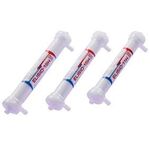Dialyzer
What is a Dialyzer?
A dialyzer is a medical device used in hemodialysis to clean the blood when the kidneys are not working properly. It acts like an artificial kidney, removing waste, extra fluid, and toxins from the blood. The dialyzer has a special filter with tiny holes that let harmful substances pass through while keeping important blood components inside.
Inside the dialyzer, blood flows through thin tubes called hollow fibers, while a special liquid called dialysate removes waste. This process helps maintain a healthy balance of fluids and minerals in the body. Dialyzers are essential for people with kidney failure to stay healthy.
How does the Dialyzer work?
A dialyzer works like an artificial kidney to clean the blood when the real kidneys are not working properly. It removes waste, extra water, and toxins from the blood, helping to keep the body healthy.
Inside the dialyzer, blood flows through tiny tubes, while a special cleaning liquid called dialysate flows around them. The tubes have tiny holes that allow waste and extra water to pass through but keep important things like blood cells inside. Once the blood is cleaned, it goes back into the body. This process helps keep the body’s fluids and minerals in balance.
What are the Uses of Dialyzer and It's Benefits?
Uses of Dialyzer:
A dialyzer is used in hemodialysis to filter waste, extra fluid, and toxins from the blood when the kidneys fail to function properly. It helps manage chronic kidney disease (CKD) and acute kidney failure, preventing harmful buildup in the body. Dialyzers are also used in intensive care units for patients requiring continuous renal replacement therapy (CRRT) in critical conditions.
Benefits of Dialyzer:
The primary benefit of dialyzers is their ability to remove waste products from the blood of patients with kidney failure. This can help to improve the quality of life for these patients and can also prolong their lives. Here are some additional benefits of dialyzers:
Removes Waste and Toxins – The dialyzer filters harmful substances, such as urea and creatinine, from the blood, preventing toxin buildup in the body.
Balances Fluids and Electrolytes – It helps maintain the correct levels of fluids, potassium, sodium, and other electrolytes, preventing complications like dehydration or fluid overload.
Supports Kidney Failure Patients – The dialyzer functions as an artificial kidney, allowing people with kidney failure to survive and manage their condition effectively.
Improves Overall Health – By removing excess waste and fluid, the dialyzer reduces symptoms such as swelling, fatigue.
Overview of Dialyzer Price:
The price of a dialyzer typically ranges between INR 700 to INR 6,000, depending on the type, brand, and quality. Low-flux dialyzers are generally more affordable, while high-flux dialyzers, which provide better filtration, cost more. Reusable dialyzers may also be priced higher due to their durability. The cost varies based on factors like membrane material, surface area, and efficiency.
Here is the price list of Dialyzer:
| S.N. | Dialyzer Models | Price |
| 1. | Dora Low Flux Dialyzer, 1.4 SQM | INR 623 |
| 2. | Fresenius FX 6 Low Flux Dialyser | INR 754 |
| 3. | Dora High Flux Dialyzer | INR 872 |
| 4. | Fresenius F6HPS Polysulfone Low Flux Dialyzer | INR 900 |
| 5. | Nipro Elisio 15M Dialyzer | INR 1,224 |
| 6. | Fresenius Diasafe Plus Dialysis Fluid Filter | INR 5,282 |
*Price maybe subject to change.
What are the different types of Dialyzer?
Dialyzers are classified based on flux, membrane type, and reuse capability. The main types are:
Low-Flux Dialyzer – This type of dialyzer has small pores in its membrane, allowing it to remove only small waste molecules like urea and creatinine. It is commonly used in standard hemodialysis and is more affordable compared to high-flux dialyzers. However, it may not remove larger toxins effectively.
High-Flux Dialyzer – This dialyzer has larger pores, which help in removing both small and large waste molecules, including middle molecules. It provides better clearance of toxins, improves dialysis efficiency, and reduces treatment time. It is often used for patients needing advanced dialysis care.
Reusable Dialyzer – This type of dialyzer is designed to be used multiple times after proper cleaning and sterilization. It is cost-effective and reduces medical waste. However, careful handling is required to prevent contamination or damage to the membrane.
Single-Use Dialyzer – This dialyzer is meant for one-time use only, ensuring maximum safety and reducing the risk of infection. It is commonly preferred in cases where hygiene and infection control are top priorities, but it is more expensive than reusable dialyzers.
Things to be considered before buying a Dialyzer:
Before buying a dialyzer, it is important to consider factors like the type, membrane material, surface area, and compatibility with the dialysis machine. Choosing the right dialyzer ensures effective blood filtration and patient safety. Here are the key things to consider:
- Type of Dialyzer
- Membrane Material
- Single-Use or Reusable
- Brand and Quality
- Price and Budget
- Compatibility
Where can you buy the Dialyzer?
Buying a dialyzer from Biomed Supplier ensures quality, reliability, and affordability. We offer a wide range of high-quality dialyzers that meet medical standards, ensuring safe and effective dialysis treatment.
Why Should You Buy the Dialyzer from Biomed Supplier?
Certified and Trusted Products – Biomed Supplier provides certified dialyzers that meet safety and performance standards.
Affordable Pricing – We offer competitive prices, making it cost-effective for hospitals, clinics, and dialysis centers.
Variety of Options – You can choose from low-flux, high-flux, reusable, and single-use dialyzers based on patient needs.
Compatibility Assurance – Our dialyzers are compatible with most dialysis machines, ensuring smooth operation.
Excellent Customer Support – Biomed Supplier offers expert guidance to help you choose the right dialyzer and provides after-sales support.
FAQ's:
1. What is a dialyzer used for?
A dialyzer is a medical device used in hemodialysis to filter waste, toxins, and extra fluids from the blood when the kidneys are not functioning properly.
2. What is the difference between high-flux and low-flux dialyzers?
High-flux dialyzers remove both small and large toxins efficiently, while low-flux dialyzers filter only small molecules like urea and creatinine.
3. How many times can a dialyzer be reused?
Reusable dialyzers can be used multiple times (up to 10-20 times) after proper cleaning and sterilization, depending on the manufacturer’s guidelines.
4. Are single-use dialyzers safer than reusable ones?
Yes, single-use dialyzers reduce the risk of infection and cross-contamination, making them safer for patients. However, they are more expensive than reusable ones.
5. How do you choose the right dialyzer?
Consider factors like type (high-flux or low-flux), membrane material, surface area, compatibility with the dialysis machine, and patient condition.
6. What is the price range of a dialyzer?
Dialyzer prices typically range between INR 700 to INR 6,000, depending on the type, brand, and quality.
7. Which brands manufacture dialyzers?
Some popular brands include Fresenius, Nipro, B. Braun, known for their high-quality and efficient dialysis products.
8. What is the difference between a dialyzer and a dialysis machine?
A dialyzer and a dialysis machine work together in hemodialysis, but serve different roles.
| Dialyzer | Dialysis machine |
| It is the filter (artificial kidney) that removes waste, toxins, and excess fluid from the blood. | It is the main device that pumps blood, controls fluid flow, and manages dialysate concentration. |
| It contains a semi-permeable membrane where the exchange of waste and electrolytes takes place. | It ensures the blood flows through the dialyzer and is safely returned to the patient. |


